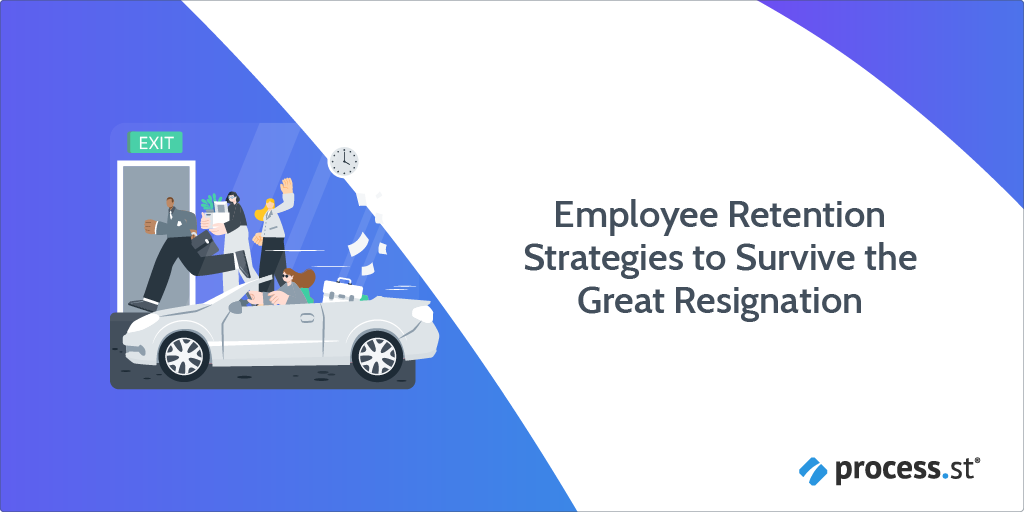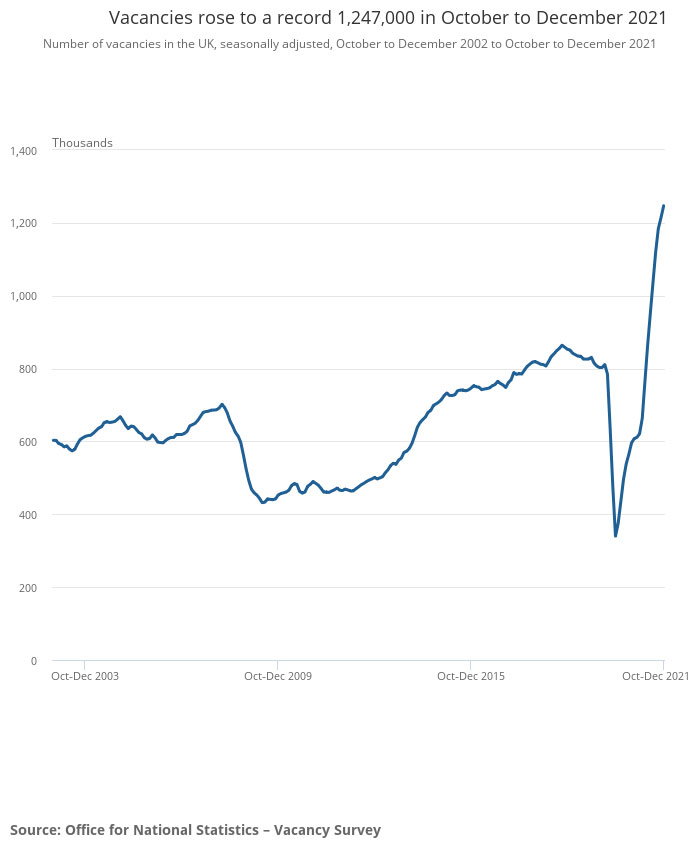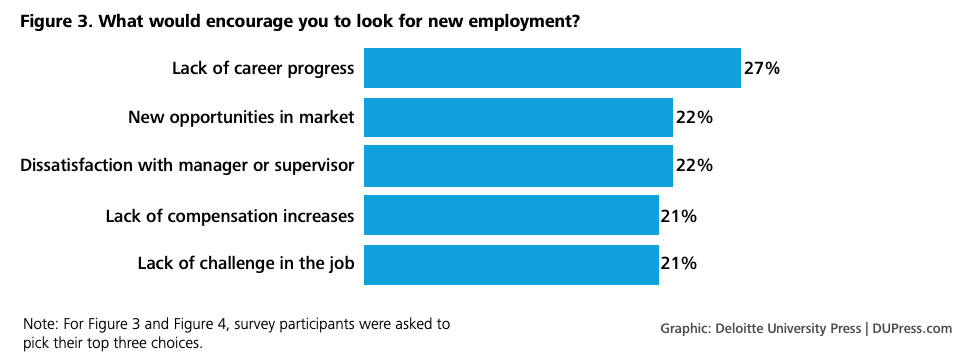
Since the outbreak of the Covid-19 pandemic, the U.S Bureau of Labor Statistics indicates that over 47 million people in the United States have voluntarily quit jobs. This phenomenon has been labeled the Great Resignation.
Another survey found that most people who quit their jobs in 2021 did so because of low pay (63%), lack of opportunities for advancement (63%), and feeling disrespected at work (57%). At least a third of those who left say that each of these was a major reason.
So, you may be looking for strategies to reduce your company’s attrition rate and keep your best employees.
In today’s world of job-hopping and freelancing, it’s not easy to keep employees on board, but that doesn’t mean you shouldn’t put in any effort.
If you’re looking to successfully get through the Great Resignation, here are some strategies you may consider implementing:
- Why employee retention is difficult during the Great Resignation
- The strategies you need to retain employees
- Benefits of catering to employees
- Employee retention strategies: Final thoughts
Why employee retention is difficult during the Great Resignation
Simply put, employee retention is difficult due to high job demands and decreased layoffs.
Here’s a quick look at the job demands in late 2021:
The economy’s resurgence contributes to the rising demand for talent, causing a huge demand-supply gap. The new jobs and roles open avenues for talent to shift to different positions and companies. Due to the increased competition for top talent, organizations are providing higher salaries, flexible work options, and more paid leaves.
While it is certainly challenging to retain employees, there are ways to overcome this hurdle, especially by implementing effective retention and recruitment strategies.
The strategies you need to retain employees
Although the Great Resignation presents challenges, it’s not something new that global businesses are facing for the first time. Many businesses have faced and overcome arguably more difficult challenges before.
While you can’t apply solutions of previous crises to the Great Resignation, the most current shift in the corporate world is still manageable by following fundamental business principles.
With the Great Resignation looming, every company should ask how they can best keep their staff. Here, we’ll discuss some strategies for attracting and retaining top talent.
1. Refine your onboarding process
Onboarding reflects what your company is and ultimately leaves the first impression on new employees. A report indicates a 2.6 times increase in job satisfaction among new employees when they have a positive onboarding experience.
You can rely on learning management tools that streamline difficult or time-consuming procedures for companies to hire new employees. Leveraging a comprehensive learning platform allows you to create personalized onboarding experiences for new employees.
Extra steps need to be taken to make sure employees joining remotely feel integrated into their team. To achieve this, you could implement a virtual onboarding program that may utilize internal bots to help facilitate a more seamless connection within your team. Check for chatbot pricing and integrate an employee engagement bot within your onboarding activities to encourage icebreaker conversations.
An positive first impression would help your new employees feel part of a family, and encourage them to succeed in their new position. Each team member should have the necessary training, events, materials, and certifications at their disposal.
2. Offer more flexibility & better tools
Think of a change; like after-sales services are reinforced by using the right customer service software, your business has to adopt flexible tools as employees demand greater flexibility.
Work-from-home success during the early days of a pandemic has made people realize that they can get the same amount of work done without commuting or even the need to stay tethered to a fixed location. The concept of employment flexibility also includes working hours with location to strike a perfect work-life balance.
A survey by Slack suggests that 72% of employees prefer a hybrid arrangement that combines the home and the office.
There is a reluctance to “return to normal” when firms begin to bring their employees back to work. And there’s a solid explanation for it — a shift in priorities is taking place in the workplace. A larger workforce demands this flexibility, and bigger corporations are offering it.
Now its your time to provide the same.
Some of your existing employees may be looking at the exit door and willing to join your competitor if they offer the flexibility of remote work. Among 1,022 professionals surveyed in a January 2021 poll, 29% said they would resign if they were no longer allowed to work from home.
Here are some of the key factors that a modern-day worker would consider when it comes to flexibility:
Time utilization ⏰
They might be doing 2 hours of commute for an 8-hour job (1/4th of their time). For the employee, this is wasted time that could otherwise be spent with friends and family.
Money
Working at an office comes with a slew of expenses (think: commuting, city rent, child care, etc.). Offering remote work flexibility would mean they could save some extra money while still being able to effectively do their job.
Flexibility
People have come to realize the true value of their time and relationships amidst the ups and downs of the pandemic. Providing work-shift flexibility coupled with remote work would enable an ideal work-life balance.
3. Prioritize employees’ progress
Your employees will prioritize your business if you prioritize them.
If we follow Maslow’s hierarchy of needs, your employees want to feel pride in being part of something bigger than themselves – the fourth stage of Esteem.
Here, your employee’s friends, family, and coworkers are aware of and appreciate the company’s accomplishments. Employees want to know that coworkers and family members appreciate their effort and see their accomplishments recognized in public. As a result, they pivot growth so much that they may decide to quit their jobs out of the fear of falling behind in the competition.
According to the Balance Careers reports, employees under the age of 34 have an average tenure of 2.8 years. An employee’s ability to get a new job might be jeopardized if they feel behind the curve in their career.
49% of professionals want their employers to assist them in improving their careers. On the contrary, 80% of workers believe their employees are not taking enough steps to unlock their growth. One way to help them grow as your business evolves is to provide them with on-the-job training.
This approach will help your team maintain its edge while grasping new industry standards. Investments in developing your existing team can help build trust and affinity that contributes to increased loyalty in the longer run.
Also, think of a different perspective to project your brand to employees. That is, attaching a stronger significance to your products/services with the help of an employee mission statement. This could help you better emotionally connect with employees.
Communicate your company’s employee mission in meetings, emails, and conferences to show how much your business values its staff’s growth and why they are an important part of the organization.
4. Incentivize with growth opportunities
One of the common ways to do away with hiring issues is to focus on your existing team. The rising competition for talent forces businesses to offer financial and educational incentives to attract candidates.
It’s therefore necessary to keep your staff happy and motivated, and provide them with the same benefits as your rivals. Try making your workplace fun and exciting by offering growth opportunities, motivating high-performers, and paying attention to what your employees have to say about the business.
Both lateral and vertical growth opportunities help boost employee retention. Employees will be more inclined to stay with your firm if they think they won’t be able to find a better opportunity elsewhere.
For instance, here’s what Deloitte found in a 2020 research on what motivates workers to hunt for new jobs:
It’s most common for employees to look for other opportunities because they believe there’s no room for growth in the company, regardless of salary or position.
Try implementing an ongoing pay boost plan to encourage employees to go above and beyond their duties. Instead of a yearly performance evaluation, try conducting the same every quarter and, depending on how well someone meets their goals, define their raise.
5. Build connections between employees
A survey by the Institute of Leadership and Management recorded that 77% of respondents said that the most significant aspect in determining job happiness was developing strong connections with coworkers.
Building a trusting environment and keeping top talent requires a strong sense of community. This is especially crucial in a job when you are working from home.
Here are some of the key ways to ensure fostering a certain camaraderie between employees:
Make time for connection
Employees will appreciate your effort to get to know them better. When things are hectic, building trust amongst coworkers is critical. This includes taking a day out for lunch, indulging in team-building activities, and arranging other entertainment evenings to help employees bond.
Fostering collaboration
Small organizations may have difficulty blending in employees from various backgrounds or working remotely. For this, you can leverage tools, like Kahoot and Polly, that help conduct polls on Slack through quizzes and run icebreaker challenges.
Encourage sharing of expertise
Employees are keen on learning from and helping each other. Empower employees by conducting expertise-driven knowledge-sharing sessions. Also, encourage others to come up and share their expertise to help others benefit.
6. Ensure employee recognition
The Great Resignation has raised employees’ expectations for higher incentives and recognition. Rewards and recognition significantly influence employee motivation and engagement because people appreciate knowing that their efforts aren’t going unnoticed.
A study by Octanner suggests that 79% of employees cite a lack of appreciation as a primary reason to quit their job.
Here are some of the key ways to implement a highly effective reward program for employees:
- You can introduce a peer-to-peer recognition program, using tools like Culture Cloud, to encourage your staff to recognize one other’s hard work regularly.
- If you want to keep your staff productive, make employee recognition a continual and integral part of business culture. Also, think of giving personalized recognition where you identify what works as the best motivation for which employee. This means you would link employees to purpose, achievement, and each other within the staff.
- You can establish certain milestones for employees, and make sure that achieving those milestones in a predetermined timeline makes them eligible for incentives as a part of your employee recognition program.
- On-floor appreciation and goodies can also go a long way in creating a sense of recognition amongst colleagues. Also, think of introducing a social component to employee recognition where you send them gifts and vouchers on work anniversaries, birthdays, marriage anniversaries, etc.
7. Build a culture of trust
A lot of your time and effort goes into finding the right people to work with you and trusting them to do their job. This creates a sense of belongingness where employees feel ‘trusted.’ Therefore, it’s better to avoid the urge to micromanage and instead provide them with all the possible resources they could need to carry out their tasks.
If you have hired them for a certain position and task, trust them! This also speaks volumes of your confidence in your hiring choice.
Here are some key ways to ensure getting the job done by trusting your employees:
Keep everyone aligned
Ensure everyone in your organization knows what the other person is responsible for. This approach would need you to ensure visibility of cross-departmental tasks and activities that each team member makes. This way, you align your staff with others without departmental business and keep processes more transparent.
Prioritize output over hours
Gone are the days of factory workers who’d be paid based on the number of hours they put to work. Modern-day work involves completing certain time-bound tasks, organizing meetings, creating reports, and much more.
Therefore, if you’re still judging employees based on the number of hours they commit, it may put them off and get them to ultimately look for other companies that fit their philosophy of performance-based pay.
Promote task & hierarchy transparency
You can’t build trust without promoting transparency. It requires you to foster a culture where workers and supervisors are honest and open about their opinions.
Also, key stakeholders should openly discuss the company’s performance, share the P&L balance sheet, and communicate future goals to increase employee confidence.
Benefits of catering to employees
Redirecting HR efforts from recruitment to employee development and retention drives employee satisfaction and prevents costly churn.
It also boosts employees’ morale, increases camaraderie, and creates a happy work environment which focuses on employee engagement. Meaningful employee development offers them incentives to stick around and genuinely care about the company’s growth.
Binding your employees’ long-term ambitions to your business goals helps build a stronger team that’s more likely to deliver outstanding results and boost business revenue.
Employee retention strategies: Final thoughts
The Great Resignation has pushed many businesses to rethink their work culture, policies, remuneration, and even working philosophy to attract and keep highly talented workers.
Implementing a mix of the techniques mentioned in this article can help retain your existing employees and attract top talent.
Make sure to take employees’ opinions on which policies they’d want to implement first to involve them in decision-making. When employees are happier and more productive, you will see your revenue and customer satisfaction grow.
Has the Great Resignation affected your organization? What strategies have worked for you and your team? Let us know in the comments below!

Steven Macdonald is a digital marketer based in Tallinn, Estonia. In the last 10 years, he’s helped e-commerce and B2B SaaS brands generate more than $100 million in new revenue through SEO, content and conversion optimization.







 Workflows
Workflows Projects
Projects Data Sets
Data Sets Forms
Forms Pages
Pages Automations
Automations Analytics
Analytics Apps
Apps Integrations
Integrations
 Property management
Property management
 Human resources
Human resources
 Customer management
Customer management
 Information technology
Information technology





Oliver Peterson
Oliver Peterson is a content writer for Process Street with an interest in systems and processes, attempting to use them as tools for taking apart problems and gaining insight into building robust, lasting solutions.